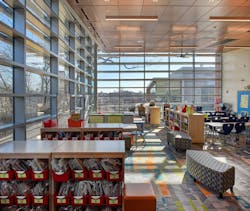How Will Education Design Change in a Post-Pandemic Environment?
Will students return to classrooms this fall? At the time of writing this in mid-July, that question hung heavily in the air, as school districts and universities across the country grappled with how best to serve their students in the new school year amid the COVID-19 pandemic.
According to statistics from Education Week, school closures in the spring of 2020 affected more than 50 million students in 124,000 U.S. public and private schools. Remote learning became the norm, and it’s likely that it will continue in some capacity for the 2020-2021 school year.
Like many other U.S. schools this spring, the Barack H. Obama Magnet University School in New Haven, CT, sent its students home to safely continue educating them virtually. Experts from JCJ Architecture, the firm that designed The Obama School in collaboration with Pickard Chilton, say its design helped students more easily transition to online learning—and designers should take note of the reasons why.
Lab School Advantage
In 2019, The Obama School—a communication lab school for pre-K through fourth grade—was relocated to a new site on the campus of Southern Connecticut State University. Students were only using the school for about three months, since December 2019, when they were sent home in the wake of COVID-19.
“They were forced into this major change and had to rethink how to do everything,” says Jim LaPosta, principal and chief architectural officer for JCJ Architecture.
But because the school’s new site was designed with agility and adaptability in mind—and because instructors often explored different teaching methods (a typical characteristic of a lab school)—The Obama School students were better equipped than some to transition to online learning.
“Because they often tried different teaching methods, different ways of grouping kids together, and understood how the building and the kids interacted, it meant that they were able to do a lot of things [online] rather quickly,” LaPosta says.
A big part of the quick transition was the school’s robust technology infrastructure. In fact, teachers initially stayed in the building amid the shutdown and were able to teach from their classrooms when students were first sent home. Students also had iPads and Chromebooks from the school that they were able to use at home.
The new site is also designed to help create small learning communities within the building, which helps foster stronger interpersonal relationships between teachers, students and their peers.
“I think that translates then when you leave the building,” LaPosta says. “Because you know your teachers, you trust them, and it makes it that much easier to make that transition to remote learning. Although I’m quite sure they all want to get back together and be in the same building as quickly as possible.”
What Will Future Education Spaces Look Like?
There’s nary an industry that COVID-19 hasn’t affected, and that includes education. What will education spaces will look like going forward? For starters, as a result of physical distancing, classroom capacity becomes much more complex.
“Let’s say a classroom used to have a 33-student capacity in it, and now it’s half,” says Peter Bachmann, principal and market sector leader for JCJ Architecture. “The question becomes: what happens to the remaining students?”
One solution being discussed is the concept of “room and Zoom,” where some students (the number depending on physical distancing capacity) are in the classroom for a lesson, while the remaining students are elsewhere (at home, their dorm room, etc.) seeing the same lesson virtually.
Bachmann says designers are also looking beyond classrooms for other areas on a campus that can be repurposed as educational spaces, including student lounges. “Student lounges typically have soft furniture meant for lounging, but they can readily be converted to educational,” he says. “It’s likely too that they have the technology needed.”
Additionally, traffic flow will be more important than ever, says LaPosta.
“It sounds mundane, but many older buildings just don’t have good traffic flow,” he explains. “That’s one of the things that The Obama School has—wide open stairs where you can see people coming and going, and this idea of seeing and being seen from a distance. The school will be able to manage people in a better way.”
In turn, moveable and agile furniture should be top of mind for designers when taking on a future education project.
“It becomes super critical, including materials, in terms of cleanability and longevity,” LaPosta says. “And also its weight. Can it be quickly rearranged for teaching while staying physically distanced?”
Designers should also think through what students touch—“they touch everything,” LaPosta says—and be increasingly thoughtful about the materials and systems they use when it comes to airflow, water and light.
A Tipping Point?
The COVID-19 crisis has given education professionals and designers the opportunity to understand what works and what doesn’t for students in this “new normal.” And permanent changes could be on the horizon.
“Over the last two decades, there have been intermittent conversations about thinking about schools and education as more of a network than a place, where learning can happen anywhere,” LaPosta says.
“This has really put that to the test in a really real way…We may see some permanent change based on educational outcomes that are not really pandemic related, where we find that certain types of learning do happen better in a split environment,” he continues. “But we’re also discovering populations, such as students with special needs, who really do need that high-touch environment when they’re in a room with an individual.”
This could be a tipping point for education which, La Posta says, “would be an interesting thing for design professionals to be a part of over the next decade.”
For more information on preparing students and staff for a safe return to schools, visit cdc.gov.
Read Next: Is Your Location Adopting Building Energy Performance Standards? Here’s What to Do
About the Author

Sarah Kloepple
Associate Editor
Sarah joined the BUILDINGS team as an associate editor in August 2018. She is a graduate of the Missouri School of Journalism, where her focus was magazine writing. She's written and edited for numerous publications in her hometown of St. Louis.
